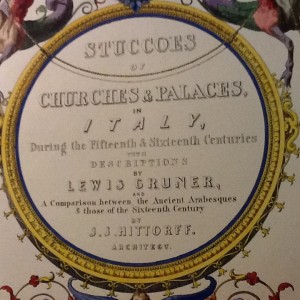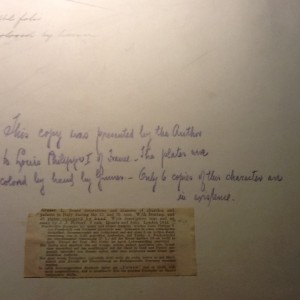Sharon L. Joffe
My recent visit to the New York Public Library resulted in an excellent discovery for our garden pavilion project. We have already noted that our guiding volume, The Decorations of the Garden-Pavilion in the Grounds of Buckingham Palace, was engraved under the “superintendence of L. Gruner.” John Malcolm Russell, in his book From Nineveh to New York (Yale University Press, 1977), explains how Ludwig (or Lewis, as he was known in England) Gruner provided Prince Albert with artistic guidance and, as an engraver, produced exquisite books on architectural matters. I was fortunate to see three of Gruner’s books, all of which are housed in the Rare Book Collection of the Schwarzman Building of the New York Public Library: Descriptions of the Plates of Fresco Decorations and Stuccoes of Churches and Palaces In Italy (1844), Fresco Decorations and Stuccoes of Churches and Palaces, In Italy (1844), and The Terra-Cotta Architecture of North Italy, XIIth – XVth centuries (1867). The equally impressive Specimens of Ornamental Art (1850) is available on-line.
Gruner is listed as the primary author on the frontispieces of all three of these texts. An exciting find was that the frontispiece to Descriptions of the Plates of Fresco Decorations and Stuccoes of Churches and Palaces in Italy identifies Gruner as “Author of ‘Specimens of Ornamental Art;’ ‘ Her Majesty’s Pavilion at Buckingham Palace Gardens;’ ‘The Ghigi Chapel,’ and of other Illustrative Works.” The engravings and illustrations in all of Gruner’s works reminded me of the drawings in our garden pavilion text as Gruner’s style is easily recognized in each of these texts. Indeed, the descriptions of the frescoes themselves show striking similarities to the ones described by Anna Jameson in her introduction to The Decorations of the Garden-Pavilion. For example, in Descriptions of the Plates of Fresco Decorations and Stuccoes of Churches and Palaces In Italy, we read of “the richly decorated ceiling … brilliant border in deep colours… adorned with the most exquisite little stuccoes and arabesques” (40). Similarly, when describing Plate 41 (“Part of the Palace of the Viscontis and Sforzas at Cusago”), Frederigo Lose (who provided the text) notes that “…the frescoes … are executed in very bright colors; amongst which are a yellow and a green, finer than any we now possess.” The accompanying sketch (see below) seems to be drawn in a manner similar to those presented in The Decorations of the Garden-Pavilion.
The most exciting and exquisite find was the massive 1844 volume Fresco Decorations and Stuccoes of Churches and Palaces in Italy, During the Fifteenth and Sixteenth Centuries ( with Descriptions by Lewis Gruner).
This tome was dedicated to Prince Albert and the Members of the Royal Commission on the Fine Arts “by their most obedient and very humble servant, Lewis Gruner” and was presented “by the author” (noted on the book’s inner cover) to King Louis Philippe I of France. A note added at the beginning of the book states that “The plates were colored by hand by Gruner – Only 6 copies of their character are in existence” (see image below). A newspaper clipping (unidentified source) has been attached to this page and it corroborates that the 46 plates were “coloured by hand.”
The most fascinating aspect of this text is found in Gruner’s Preface. He records: “At a moment when the study of art in this country appears to be guided by a new spirit, and the erection of the Houses of Parliament upon a scale of unusual splendour gives additional interest to every kind of architectural embellishment, it cannot be doubted that the access afforded to compositions of such skill and beauty, as are comprised in this work, will be gratefully acknowledged even by those Painters who efforts are directed to the higher branches of the profession.” The connection between art and the need to create a British artistic identity is clearly seen here, and connects directly with the ideas expressed by Jameson in her introduction to The Decorations of the Garden-Pavilion in the Grounds of Buckingham Palace: “The introduction, or rather the revival of Fresco Painting in this country has become, in connexion with a great national monument, a topic of general interest, an affair of national importance, and no longer merely a matter of private or artistic speculation” (5).
While these three texts did not mention the garden pavilion, they certainly showed Gruner’s ability to reproduce faithfully the art and architecture he studied and appreciated. For me, it was indeed a pleasure to be afforded a glimpse into the world of Gruner and the art he admired.

